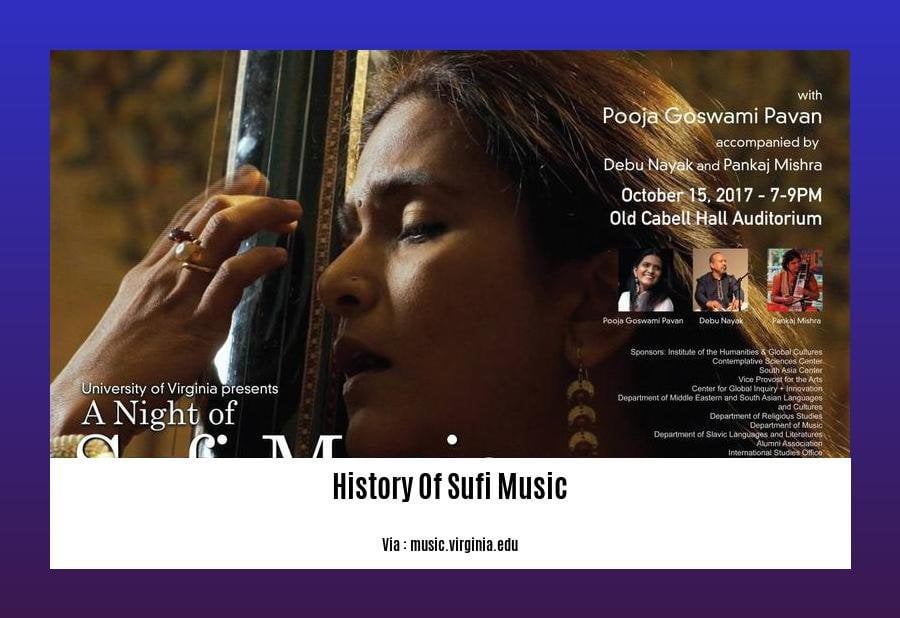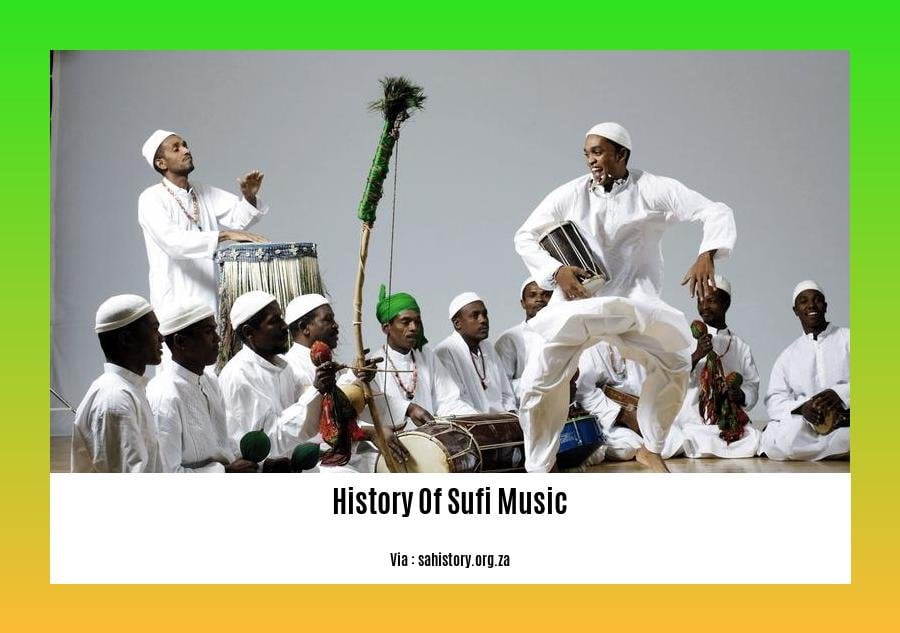Step into the enchanting world of Sufi music as we embark on a journey through its sacred sounds of devotion. From its mystical origins in the Middle East to its captivating spread across the globe, Sufi music has played a profound role in the cultural and spiritual landscape of countless communities. Prepare to delve into the rich history, diverse traditions, and transformative power of this captivating musical tradition. [- The History of Sufi Music: A Journey Through the Sacred Sounds of Devotion] promises an immersive exploration of the music that has touched the hearts and souls of millions.
Key Takeaways:
Sufi music emerged in 8th-century Persia (present-day Iran).
Sufi music flourished in various countries, shaping local cultures in Egypt, the Caucasus, Indonesia, Morocco, the Balkans, Turkey, and Senegal.
In the late 13th century, Amir Khusrow merged Persian, Arabic, Turkish, and Indian musical traditions to establish Qawwali in India.
Sufi music was introduced in Bollywood and modern India by musicians like Shankar-Shambhu and Nusrat Fateh Ali Khan.
History of Sufi Music

Sufi music, an enchanting tapestry of sounds and emotions, has captivated hearts and transcended boundaries for centuries. With origins in 8th-century Persia, it’s a melodic testament to the spiritual journey, intertwining the sacred and the earthly.
The Mystic Roots: Birth and Spread of Sufi Music
Emerging from the Sufi tradition, this music was more than just entertainment – it was a devotional offering, a medium for spiritual seekers to connect with the divine. Beginning in Persia, it journeyed across nations, embraced by Egypt, the Caucasus, Indonesia, Morocco, the Balkans, Turkey, and Senegal, resonating with diverse cultures.
Qawwali: A Fusion of Cultures
Qawwali, the popular Sufi genre, owes its existence to Amir Khusrow, an Indian musician, who blended Persian, Arabic, Turkish, and Indian traditions in the late 13th century. This unique fusion created a mesmerizing genre that continues to inspire and captivate listeners.
Sufi Music in Modern Times: Bollywood and Beyond
The allure of Sufi music has extended into contemporary times, finding a home in Bollywood and modern India. Artists like Shankar-Shambhu and Nusrat Fateh Ali Khan have played a significant role in introducing Sufi music to a broader audience, showcasing its versatility and emotional power.
Delve into the captivating journey of street dance and its evolution from its humble beginnings to its global influence. history of street dance
Discover the fascinating history of streetwear, from its underground roots to its rise as a global fashion phenomenon. history of streetwear
Embark on a sweet adventure through the history of sugar, tracing its evolution from a rare commodity to a ubiquitous ingredient. history of sugar timeline
Sufi music encompasses a diverse range of styles, influenced by various regional traditions and cultural exchanges between Sufi communities.
The rich tapestry of Sufi music unfolds across a kaleidoscope of cultural influences and regional traditions. Sufi music encompasses a diverse range of styles, influenced by the tapestry of Sufi communities.
As Sufis traversed geographical boundaries, they brought with them their musical traditions, leading to a fusion of sounds and styles. In India, Qawwali, with its rhythmic fervor and poetic verses, reigns supreme. Pakistan’s Sufi music boasts a diverse array of regional traditions, each adding a unique flavor to the musical landscape. In the Middle East, traditional Sufi music blends with intricate melodies and instrumentation, creating a captivating soundscape.
The mystical poetry of Rumi, Hafiz, and other Sufi masters has inspired musicians across the globe to create enchanting compositions. Their words, imbued with spiritual wisdom and love, have found expression in melodies that resonate with the soul.
From the devotional strains of Qawwali to the harmonious blend of traditional and modern sounds, Sufi music stands as a testament to the power of cultural exchange.
Key Takeaways:
Sufi music’s diversity stems from the intermingling of various regional traditions as Sufi communities traversed different lands.
Notable styles include Qawwali in India, regional traditions in Pakistan, and intricate melodies in the Middle East.
Sufi music draws inspiration from the mystical poetry of Rumi, Hafiz, and other masters, giving voice to their spiritual wisdom and love.
The fusion of traditional and modern sounds has created a dynamic and ever-evolving genre of Sufi music, captivating audiences worldwide.
Citations:
Sufi Music of India and Pakistan: Sound, Context, and Meaning in Qawwali
Prominent instruments in Sufi music include the ney (flute), tanbur (lute), qawwali (devotional singing), and the rhythmic handclapping and body movements known as “dhikr”.

Sufi music is characterized by several prominent instruments that contribute to its distinct sound and spiritual essence. These instruments play a vital role in creating a captivating auditory experience for listeners. Here are some of the key instruments commonly found in Sufi music:
1. Ney (Flute):
– The ney, a reed flute, holds a significant place in Sufi music.
– Its beautiful, whispering sound, akin to the gentle rustling of leaves, is believed to mimic the human breath, creating a deeply immersive experience for listeners.
– It is often used to evoke a sense of longing and connection with the divine.
2. Tanbur (Lute):
– The tanbur, a plucked lute, is another essential instrument in Sufi music.
– Its warm, resonant tones create a soothing and meditative atmosphere.
– The tanbur’s strings symbolize the connection between the human and the divine, representing the journey of the soul towards enlightenment.
3. Qawwali (Devotional Singing):
– Qawwali, a genre of devotional singing, is one of the most well-known forms of Sufi music.
– It originated in the Indian subcontinent and is characterized by its powerful vocals, often accompanied by clapping and rhythmic body movements.
– Qawwali performances are often held at Sufi shrines or gatherings, creating a deeply immersive and spiritual experience for participants.
4. Dhikr (Rhythmic Handclapping and Body Movements):
– Dhikr refers to the rhythmic handclapping and body movements that are commonly seen in Sufi music performances.
– These movements are not just for aesthetic purposes; they serve a spiritual function, helping participants to focus their minds, connect with the divine, and achieve a state of trance or spiritual ecstasy.
Key Takeaways:
The ney (flute) is a prominent instrument in Sufi music, producing a whispering sound that symbolizes the human breath and evokes a sense of longing and connection with the divine.
The tanbur (lute), with its warm and resonant tones, symbolizes the connection between the human and the divine and represents the journey of the soul towards enlightenment.
Qawwali (devotional singing) is a well-known form of Sufi music characterized by powerful vocals, often accompanied by clapping and rhythmic body movements, creating a deeply immersive and spiritual experience for participants.
Dhikr (rhythmic handclapping and body movements) helps participants to focus their minds, connect with the divine, and achieve a state of trance or spiritual ecstasy.
Sources:
1. Sufi Music – Wikipedia
2. Know About Sufi Music Origin And Instruments Used Since Ages
Sufi Music: Enduring Melodies of Spirituality and Devotion
Sufi music holds a significant place in the cultural heritage of many countries, particularly in the Middle East, Central Asia, South Asia, and North Africa, and continues to be practiced and enjoyed by millions of people worldwide.
These musical expressions serve as a testament to the rich spiritual and cultural history of Sufism, a mystical branch of Islamic tradition. Join me as we take a glimpse into the captivating melodies and enchanting rhythms of Sufi music.
Origins and Evolution
Sufi music, a diverse and multi-faceted art form, emerged as a means of spiritual expression within Sufi communities. Rooted in the Middle East, it flourished throughout the centuries, weaving together influences from various cultures.
Central to Sufi Practices
Music plays a pivotal role in Sufi rituals and devotional practices. It serves as a conduit for connecting with the divine, fostering spiritual ecstasy, and promoting unity among believers. Sufi music enhances the atmosphere of gatherings, creating an immersive experience for participants.
Diverse Soundscapes
The world of Sufi music is remarkably diverse, encompassing various regional styles and traditions. Each region has its own unique flavors, reflecting cultural and linguistic differences.
Qawwali: Originating in the Indian subcontinent, qawwali is a popular form of Sufi music characterized by its energetic and passionate performances.
Sama: Rooted in the Middle East, sama is a Sufi ritual involving sacred music, dance, and trance-like states.
Ayin: A form of Sufi music and dance practiced by the Whirling Dervishes, a mystical order known for their mesmerizing performances.
Sufi Music Today
In contemporary times, Sufi music continues to thrive, captivating audiences worldwide. Its appeal extends beyond cultural and religious boundaries, resonating with people from diverse backgrounds.
Global Stage: Sufi music has gained international recognition, gracing stages around the world. Renowned artists such as Nusrat Fateh Ali Khan and Abida Parveen have played a significant role in popularizing Sufi music globally.
Cross-Cultural Collaboration: Sufi music has inspired collaborations with musicians from different genres, leading to innovative fusions and intercultural dialogue.
Key Takeaways:
- Diversity: Sufi music encompasses a wide range of styles and traditions, reflecting the regional and cultural diversity of the Islamic world.
- Spirituality: It serves as a means of spiritual expression and connection with the divine, playing a central role in Sufi rituals and devotional practices.
- Global Appeal: Sufi music has gained international recognition and continues to captivate audiences worldwide, transcending cultural and religious boundaries.
- Cultural Heritage: It holds a significant place in the cultural heritage of many countries, serving as a testament to the rich spiritual and cultural history of Sufism.
Relevant Sources:
[1] https://en.wikipedia.org/wiki/Sufi_music
[2]
FAQ
Q1: How did Sufi music originate?
A1: Sufi music emerged in Persia (modern-day Iran) during the 8th century as a form of devotional expression among Sufi mystics. Inspired by the teachings of Sufi poets, it combined elements of traditional Persian music with spiritual lyrics and practices.
Q2: How did Sufi music spread beyond its origins in Persia?
A2: Sufi music’s popularity extended beyond Persia through the travels and teachings of Sufi masters and musicians. As Sufi communities established themselves in various regions, such as Egypt, India, Turkey, and North Africa, they carried their musical traditions along, leading to the incorporation of local musical influences and the emergence of distinct regional styles of Sufi music.
Q3: Which Sufi musicians have significantly contributed to the genre’s evolution?
A3: Throughout history, many renowned Sufi musicians have played a pivotal role in shaping and popularizing Sufi music. Among them are Amir Khusrow, who blended Persian, Arabic, Turkish, and Indian musical elements to create Qawwali in the 13th century; Abida Parveen and Nusrat Fateh Ali Khan, who introduced Sufi music to Bollywood and modern India; and A. R. Rahman, an Academy Award-winning composer who has incorporated Sufi influences into his film scores.
Q4: What are some of the key instruments commonly used in Sufi music?
A4: Sufi music is characterized by the use of a variety of instruments, including the Ney (reed flute), which holds symbolic significance as a representation of the human soul’s longing for divine connection; the Tabla (paired drums), providing rhythmic accompaniment; the Sitar (stringed instrument), known for its expressive melodies; and the Qawwali harmonium, a modified version of the harmonium specifically used in Sufi devotional music.
Q5: How has Sufi music influenced contemporary music and popular culture?
A5: Sufi music has left a lasting impact on contemporary music and popular culture. Its spiritual and emotional depth has resonated with musicians across genres, leading to collaborations and incorporations of Sufi elements in various musical styles. Artists like Madonna, Loreena McKennitt, and Rabbi Shergill have drawn inspiration from Sufi music, while bands like Junoon have created fusion genres such as Sufi rock. Additionally, Sufi music has found a place in Bollywood films, further expanding its reach and influence in popular culture.
- Red Cloud, NE: Discover Willa Cather’s Legacy - April 11, 2025
- Remember Old Social Media Sites? Their Rise and Fall - April 11, 2025
- How many days till Feb 3?Accurate Countdowns & Tools - April 11, 2025
















